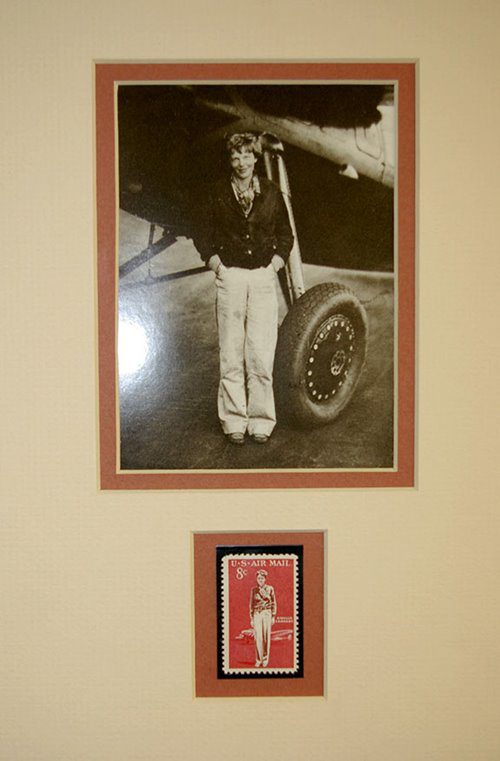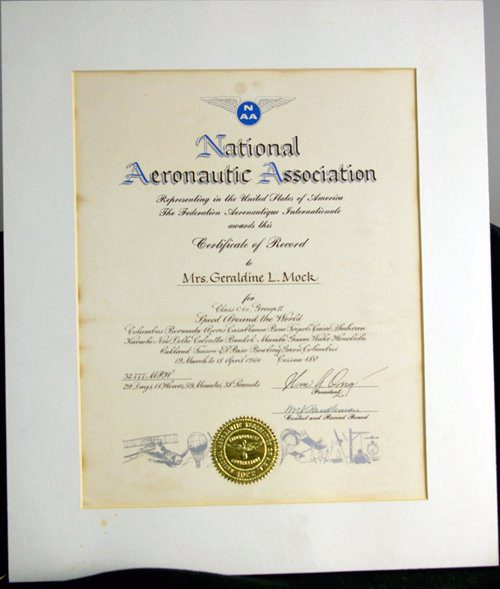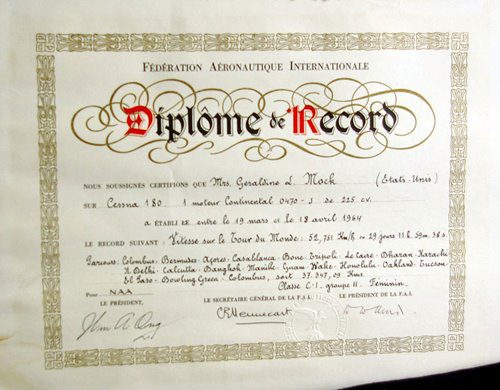When you think of famous pilots from Ohio, what names come to mind? The Wright Brothers? Maybe Eddie Rickenbacker? Or Amelia  Earhart? As this summer began, these probably would have been the only names on our minds, too. But then we began processing a collection of paper objects coming from the former Ohio History of Flight Museum. We have stumbled across pilots’ maps from World War II, articles detailing the safe return of Eddie Rickenbacker, a signature from a Wright brother and plenty of pictures from the Port Columbus Airport in Columbus, Ohio. But we never expected to stumble upon the story of another important Columbus area pilot: Geraldine Mock.
Earhart? As this summer began, these probably would have been the only names on our minds, too. But then we began processing a collection of paper objects coming from the former Ohio History of Flight Museum. We have stumbled across pilots’ maps from World War II, articles detailing the safe return of Eddie Rickenbacker, a signature from a Wright brother and plenty of pictures from the Port Columbus Airport in Columbus, Ohio. But we never expected to stumble upon the story of another important Columbus area pilot: Geraldine Mock.
 In 1964, Jerrie Mock climbed into her plane, The Spirit of Columbus, started the engine and began a journey all the way around the world, making her the first female pilot to successfully circumnavigate the globe. And we have the certificate to prove it.
In 1964, Jerrie Mock climbed into her plane, The Spirit of Columbus, started the engine and began a journey all the way around the world, making her the first female pilot to successfully circumnavigate the globe. And we have the certificate to prove it.
Mock grew up in Newark, Ohio, with parents who took her for her first flight at an early age. After this experience, Jerrie became enthralled with aviation, deciding she wanted to be a pilot one day. This may have been a unique aspiration, but as Mock once said, she “did not conform to what girls did. What girls did was boring.”[1] After nearly completing her degree in aeronautical engineering at The Ohio State University, Mock married and settled in Bexley, Ohio, with her husband and eventually had three children. Mock never intended to fly around the world. But then one night, when boredom caught up with Jerrie again, Mr. Mock turned to his wife and said, “Maybe you should just get in your plane and fly around the world.”[2] And so she did.
Jerrie left Columbus on March 19, 1964. Her plane, an eleven-year-old Cessna 180, had been modified to carry more fuel in place of the original passenger seats. Dressed in a skirt and heels that she kicked off once in the air, “the flying housewife” was on her way around the world in silence.[3] The quiet was due to the nature of the journey and a result of a seemingly purposely disconnected radio wire, the first of several minor problems she encountered over the next 29 days.
Issues with ice and The Spirit of Columbus’s brakes and engine caused delays, including a week in Bermuda during bad weather, but Jerrie pressed on. Meanwhile, Joan Merriam Smith, who was simultaneously attempting to fly around the world, encountered her own problems that kept her far behind Mock. With Mock’s husband egging her on to finish first, Jerrie had little time for sightseeing, flying as long as 17 hours at a time and on an average of 5 hours of sleep. She did have time, however, to achieve her goal of riding a camel while in Egypt (where she had accidentally landed at a restricted base). In Saudi Arabia, a crowd cheered when she exited her plane alone and without a man. Flying over Vietnam she noted, “Somewhere not far away a war was being fought, but from the sky above all looked peaceful.”[4]
Upon her return to Columbus, 5,000 people greeted her with applause. She had completed her trip and set seven records in the process.  Post-flight, Jerrie appeared on several television programs, was awarded a medal by President Lyndon B. Johnson and became the first woman honored with the Louis Bleriot silver medal by the Federation Aeronautique Internationale. She also wrote a memoir, Three Eight Charlie. The Spirit of Columbus now resides at the Smithsonian, and a statue of Mock can be admired at Port Columbus. Mock died in 2014 at 88 years old, shortly after the 50th anniversary of her flight, leaving behind a legacy of spirit and determination.
Post-flight, Jerrie appeared on several television programs, was awarded a medal by President Lyndon B. Johnson and became the first woman honored with the Louis Bleriot silver medal by the Federation Aeronautique Internationale. She also wrote a memoir, Three Eight Charlie. The Spirit of Columbus now resides at the Smithsonian, and a statue of Mock can be admired at Port Columbus. Mock died in 2014 at 88 years old, shortly after the 50th anniversary of her flight, leaving behind a legacy of spirit and determination.
[1] Rinehart, Earl. “Jerrie Mock, First Woman to Fly Solo Around the Globe, Dies at 88.” Columbus Dispatch. October 2, 2014.
[2] Weber, Bruce. “Jerrie Mock, First Solo Female Pilot to Circumnavigate the Globe, Dies at 88.” New York Times. October 4, 2014.
[3] Saunders, Amy. “How an Ohio Housewife Flew Around the World, Made History and Was Then Forgotten.” Buzzfeed. April 12, 2014.
[4] Weber, Bruce. “Jerrie Mock, First Solo Female Pilot to Circumnavigate the Globe, Dies at 88.” New York Times. October 4, 2014.